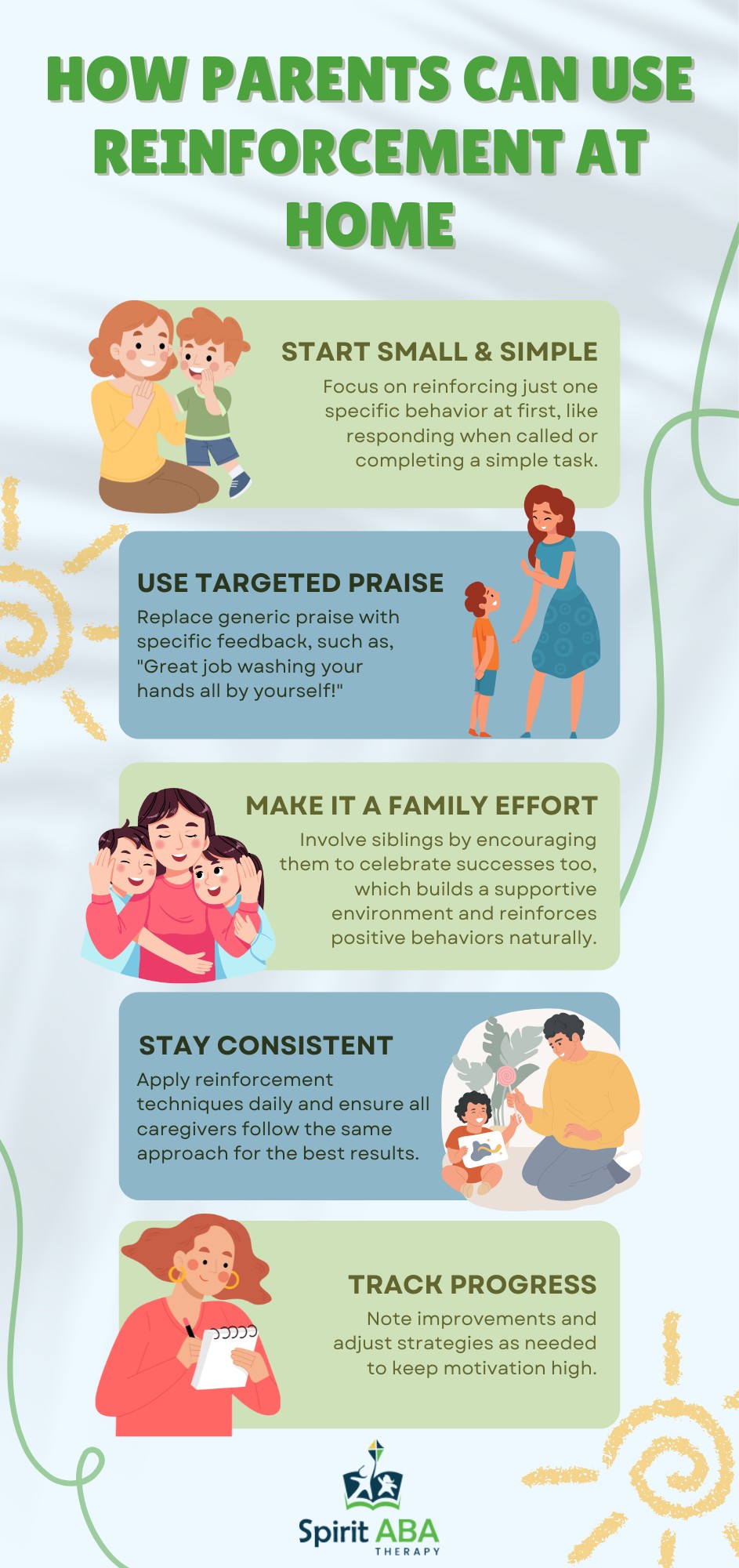Key Points:
- Positive reinforcement is a powerful tool in autism therapy that rewards desired behaviors to encourage repetition.
- Effective reinforcement autism techniques include praise, token systems, and preferred activities tailored to each child’s needs.
- Consistent use of positive reinforcement in ABA therapy can improve communication, social skills, and daily functioning.
If you’ve ever felt stuck in a cycle of challenging behaviors, you’re not alone. Positive reinforcement offers a breakthrough. By focusing on what works rather than what doesn’t, we can help our children with autism build lasting skills – one encouraging moment at a time.

What Is Positive Reinforcement in Autism?
Positive reinforcement works exceptionally well for children with autism. It’s a behavioral strategy where desired behaviors are followed by rewards, making them more likely to occur again. For parents exploring reinforcement autism techniques, this approach is both evidence-based and adaptable to each child’s unique preferences.
Unlike punishment or criticism, positive reinforcement focuses on building strengths rather than eliminating challenges. For example, if a child says “please” when asking for a toy, giving enthusiastic praise or the toy itself reinforces that polite behavior. Over time, this creates meaningful, lasting changes in how children learn and interact.
Why Is Positive Reinforcement Effective for Autism?
Children with autism often thrive on predictability and clear cause-and-effect relationships. Positive reinforcement provides both by immediately connecting good behavior with positive outcomes. This method is particularly effective because it:
- Builds confidence: Success and rewards encourage children to try new skills.
- Reduces anxiety: Clear expectations minimize frustration during learning.
- Strengthens relationships: Shared celebrations create trust between children and caregivers.
Research shows that reinforcement autism strategies are most successful when rewards are personalized. A child who loves stickers may work hard to earn them, while another might respond better to extra playtime. The key is observing what motivates your child.
Common Positive Reinforcement Techniques
Wondering how to apply reinforcement autism methods at home or in therapy? These practical strategies are widely used in ABA programs:
1. Verbal Praise and Encouragement
Simple phrases like “Great job sharing!” or “I love how you used your words!” highlight specific behaviors. For children who are less responsive to verbal praise, pair it with smiles, high-fives, or hugs.
2. Token Economy Systems
Tokens (e.g., stars, points, or poker chips) are earned for target behaviors and exchanged for larger rewards, like a favorite activity or a small toy. This teaches delayed gratification and goal-setting.
3. First-Then Boards
A visual tool showing a non-preferred task (e.g., “First, clean up”) followed by a preferred activity (e.g., “Then, play outside”). This clarifies expectations and makes transitions easier.
4. Natural Reinforcement
Rewards that directly follow a behavior, such as receiving a snack after asking politely. This helps children see the natural benefits of communication.
5. Sensory Reinforcers
For children motivated by sensory input, rewards might include swinging, bubble-blowing, or time with a favorite textured object.
Tailoring Reinforcement to Your Child
Not all rewards work equally well. Here’s how to identify what motivates your child:
- Observe their preferences: Note which toys, foods, or activities they gravitate toward.
- Offer choices: Present two reward options to gauge interest (e.g., “Do you want bubbles or music after you finish?”).
- Rotate reinforcers: Prevent boredom by alternating rewards to maintain excitement.
If a reward stops working, it’s okay to switch it up! Flexibility ensures continued engagement.
Mistakes to Avoid With Positive Reinforcement
Even well-intentioned efforts can backfire. Steer clear of these pitfalls:
- Inconsistent rewards: Skipping reinforcement confuses children. Reward every success initially, then taper off.
- Delayed praise: Immediate feedback (“Awesome sitting!”) works better than saying it minutes later.
- Over-reliance on treats: Mix edible rewards with social praise to avoid dependency.
How Parents Can Use Reinforcement at Home
Creating consistency between therapy and home life is crucial for maximizing progress. Here are practical ways to implement positive reinforcement effectively:

By incorporating these simple but powerful techniques, you can create a structured, encouraging home environment that complements therapeutic goals.
Unlock Your Child’s Potential with ABA Therapy in Nebraska, Iowa and Colorado
Positive reinforcement is just one piece of the puzzle. At Spirit ABA, our ABA therapy in Nebraska, Iowa and Colorado uses these strategies and more to help children with autism build essential life skills in a supportive, engaging environment.
Ready to see the difference? Contact us today to learn how our personalized ABA programs can help your child thrive!


